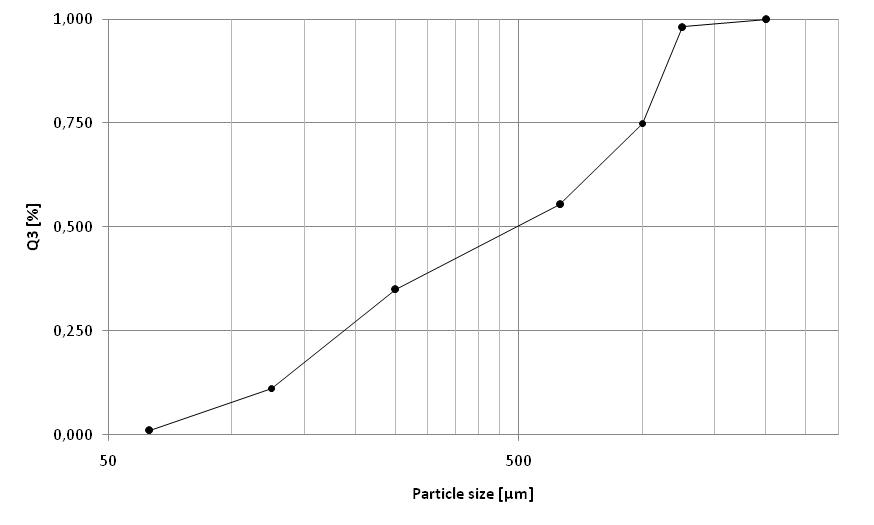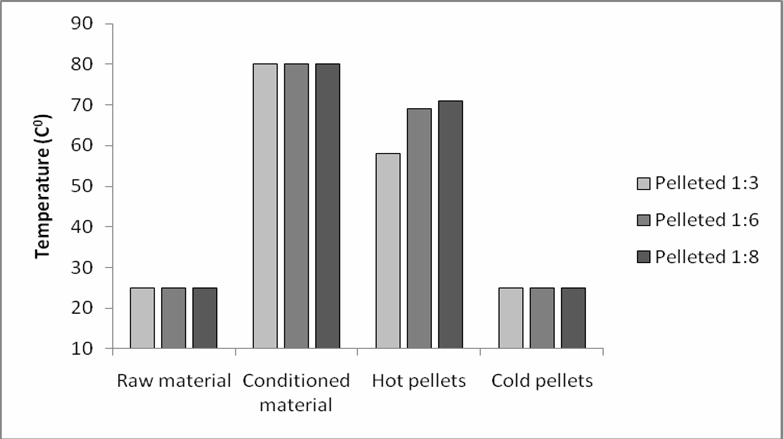ABSTRACT
ABSTRACT
The purpose of this study was to investigate the effects of length of die channel press way on physical quality of pelleted cattle feed. Pellet processing of compound feed was carried out at the Institute of Food Technology, Novi Sad, Serbia. For this study the complete mixture for dairy cows was acquired. Mixture was made from corn, wheat meal, sunflower meal, soybean meal, limestone, dicalcium phosphate and premix. Mixture was pelleted on flat die pellet press. Three dies with different die thicknesses were used. Diameter of die openings of all three dies was 6 mm, and die press ways were 18, 36 and 48 mm respectively (D/L 1:3, 1:6, and 1:8). Increase of length of die channel press way improved the pellet quality in terms of hardness. Thus, pellets made at 1:8 die had the highest value of hardness. Differences between all three groups were significant (p<0.05). Pellet durability results are not in correlation with press way length. This is presumably due to the difference in moisture content because moisture has lubricating effect. Moisture content had higher influence on the pellet durability when comparing with the die press way length. When increasing press way from 1:3 to 1:6, specific energy consumption is increased approximately 40%. On the other hand, when using 1:8 die, specific energy consumption was increased by only 5%. Reason for this is higher moisture content for 1:8 die.
INTRODUCTION
Pelleting is a process of forcing and shaping bulk material trough die with specific dimensions of openings and thickness. Although, with cost of approximately 60% higher when comparing with mash feed, pelleting process has numerous advantages such as: better flow properties, higher bulk density, no segregation, etc. Aim of pelleting process is to obtain feed pellets with optimized physical and improved nutritional quality, in order to meet the requirements for specific animal category (in terms of better feed intake and improved nutritional value). Also, depending on type of transportation and handling it is necessary to obtain pellets of certain integrity without fines produced by attrition stresses. This could be achieved by varying diet formulation and its physical quality, or, when this is not possible, by changing technological parameters in pelleting process, such as: conditioning time and temperature, dosing speed, roller (or die) speed, distance between die and roller, die thickness, die openings diameter, etc. It is very important that highly skilled personnel runs pellet press in order to optimize parameters for achieving the least possible cost in terms of energy consumption and wear. (Thomas et al., 1997; Pfost 1963; Pfost, 1971).
Steam conditioning of mash animal feed, before pelleting process, is introduced in pellet production in order to convert mixed mash with use of heat, water, pressure and time, to a physical state which is more suitable for compaction of feed mash. Conditioning increases production capacity and, at the same time, affects physical, nutritional, and hygienic quality of produced feed (Sredanović and Lević, 2000, Vukmirović, 2010).
Addition of heat and water leads to changes of components, such as starch and protein, in a way that binding property comes into effect. Production output, energy consumption and pellet quality are closely dependent on applied steam conditioning process. Properly conditioned feed mash will give pellets with good physical and hygienic quality, together with improved nutritional value of feed (Thomas et al., 1997; Winowiski, 1985).
A usual procedure, when analyzing pellet physical quality, is determination of pellet hardness and durability. Hardness is defined as force necessary to crush a pellet or a series of them at the same time. Hardness is determined by using equipment which measures force needed to fragment the pellet. For simulation shearing and abrasion during transportation in practical feed manufacturing, which induces fines in the feed, durability test is used. Durability test is defined as the amount of fines returning from the pellets after being treated with mechanical or pneumatic agitation (Skoch et al., 1983; Stevens, 1987; Pfost 1963).
Aim of this study is to examine effect of length of die channel press way on hardness and durability of pelleted cattle feed.
Material and Methods
Pelleting process was carried out at the feed processing pilot plant of the Institute of Food Technology, Novi Sad, Serbia. For the study the complete mixture for dairy cows was used. The compound feed was made from corn, wheat meal, sunflower meal, soybean meal, limestone, dicalcium phosphate and premix.
Analysis of the chemical composition was performed at the Institute of Animal Science of Lithuanian Veterinary Academy, Baisogala, Lithuania. The chemical composition of cattle feed mixture was determined using standard methods (AOAC, 1990) and is presented in Table 1.
Table 1. Chemical composition of dairy cow feed
|
Chemical composition (%)
|
|
Dry matter (DM)
|
88.67
|
|
Crude protein
|
20.57
|
|
Crude fat
|
2.81
|
|
Crude fiber
|
10.22
|
|
Nitrogen free extracts (NFE)
|
49.21
|
|
Crude ash
|
5.86
|
Cumulative particle size distribution was determined by standard sieving analysis in the range 63 to 2000 μm (Endecotts Ltd., United Kingdom) and shown in Fig. 1.
Feed mash was steam-conditioned in a double-shaft steam conditioner, Muyang SLHSJ0.2A (China). Maximum temperature during conditioning process was 80 oC. Pressure of injected steam was 2 bar. Material moisture content after conditioning process was 16.2 ± 1%.
The material was pelleted on a flat die pellet press 14-175, AMANDUS KAHL GmbH & Co. KG (Germany). Three dies with different die thickness were used. Diameter of the die openings of all three dies was 6 mm, and die press ways were 18, 36 and 48 mm respectively (D/L 1:3, 1:6, and 1:8). After pelleting, pellets were stored for 24 hours under room conditions in order to achieve stabile temperature.
 Fig. 1.
Fig. 1. Cumulative particle size distribution of dairy cow feed.
Bulk density was measured with a bulk density tester, Tonindustrie, West und Goslar, Germany. Moisture content during the pelleting process was determined with a rapid moisture analyzer (OHAUS MB 45, Switzerland).
Pellet hardness was determined with “Pellet Hardness Tester“, AMANDUS KAHL GmbH & Co. KG, Germany. A pellet is inserted between two bars, and by manually increasing static pressure, force needed to crack the pellet is determined.
 Fig. 2.
Fig. 2. Pellet hardness tester
Durability of pellets was determined with “Pellet Durability Tester“, Bühler, Switzerland. It is determined by inducing fines trough abrasion action of pellets, shearing over each other and over the wall of drums (tumbling can device). This procedure is standardised by using a drum with specified dimensions, in which 500 g of sieved pellets are inserted. After tumbling for 10 min at 50 rpm, pellets are subsequently sieved and the amount of fines passing a sieve with a grid size of 0.8 x pellet diameter was determined. Durability is expressed as the ratio of the weight tumbling over the weight before tumbling, multiplied with 100, and given as percent. Statistical Analysis System (Statistical, Tulsa, Oklahoma, USA) was used for analyzing variations (analysis of variance – ANOVA) and least significant differences (LSD). The level of significance was set at p<0.05.
Results and Discussion
Fig. 3 shows the moisture content of material during the pellet processing. Addition of steam during conditioning induced an increase in the material moisture content. At the outlet of pellet press, material had “flush off” of water of approximately 1%. Cold pellet (after 24h) had additional 1% water loss.
 Fig. 3.
Fig. 3. Moisture content of material during processing
When observing Fig. 4 where temperature of material in pellet processing is shown it could be noticed that the temperature of material is in correlation with the length of die channel press way. Higher press way length induces higher friction between material and die surfaces. The highest temperature was achieved using 1:8 die, although with 1:6 die, the temperature was only 2 °C lower, possibly due to higher moisture content for this die.
 Fig. 4.
Fig. 4. Temperature of material during processing
Bulk density of material trough the pelleting process is shown in Fig. 4. It can be seen that bulk density of the conditioned material is slightly lower in comparison with raw (unconditioned) material. This was already shown in literature (Vukmirović at al., 2010). Bulk density of pelleted material is significantly (p<0.05) increased when comparing with mash material, as was expected. On the other hand, the highest bulk density value was achieved with 1:6 pellets, although 1:8 die had the longest press way. This is possibly due to the lower moisture content during conditioning for 1:6 die, because moisture has lubricating effect during pelleting process, so friction was higher due to moisture lack.
 Fig. 5.
Fig. 5. Bulk density of material during processing
Results are given as mean ± Standard deviation
Results of pellet hardness are shown in Table 2. Increase of length of die channel press way improved pellet quality in terms of hardness. Thus, pellets made at 1:8 die had the highest value of hardness. Differences within all three groups were significant (p<0.05).
Table 2. Pellet hardness
|
Pellet hardness (KH)†
|
|
Pelleted 1:3
|
4.39 ± 0.59a
|
|
Pelleted 1:6
|
7.49 ± 1.30b
|
|
Pelleted 1:8
|
9.03 ± 1.42c
|
Results are given as mean ± standard deviation of 15 measurements
aMeans with different letters in the same column for each sample are significantly different (p<0,05)
†Kahl hardness
When analyzing the results for pellet durability (Table 3) it could be seen that the results are not in correlation with the press way length. This is possibly due to the moisture content difference. As already explained, moisture has lubricating effect. So, it could be concluded that moisture content had higher influence on pellet durability when comparing with die press way length.
Table 3. Pellet durability
|
Pellet durability (%)
|
|
Pelleted 1:3
|
5.73 ± 0.24a
|
|
Pelleted 1:6
|
1.41 ± 0.38b
|
|
Pelleted 1:8
|
3.84 ± 0.01c
|
Results are given as mean ± Standard deviation of 15 measurements
aMeans with different letters in the same column for each sample are significantly different at the 5 % level
Values of specific energy consumption in the pelleting process are shown in Table 4. When increasing press way from 1:3 to 1:6, the specific energy consumption increased approximately by 40%. On the other hand, when useing 1:8 die, the specific energy consumption increased only by 5%. Reason for this is higher moisture content for 1:8 die. So, it is very important to optimize the press way length and moisture content to achieve appropriate specific energy consumption in the process.
Table 4. Specific energy consumption in the pelleting process
|
|
Energy consumption (kWh/t)
|
|
Pelleted 1:3
|
42.16 ± 2,69a
|
|
Pelleted 1:6
|
60.19 ± 2,93b
|
|
Pelleted 1:8
|
63.52 ± 4,17c
|
Results are mean ± Standard deviation of 11 measurements
aMeans with different letters in the same column for each sample are significantly different (p<0,05)
Conclusions
Optimization of pelleting process is very important in terms of obtaining high quality products with low production costs. Increase of die channel press way improved the pellet hardness, but also increased production costs. Higher moisture content achieved during conditioning had lubricating effect, decreased friction in the die channel, decreased the specific energy consumption, but also impaired pellet durability, even when longer press way was used.
Acknowledgements
This paper is a result of the research within the project III046012 “Istraživanje savremenih biotehnoloških postupaka u proizvodnji hrane za životinje u cilju povećanja konkurentnosti, kvaliteta i bezbednosti hrane za životinje (Study of modern biotechnological methods in the production of animal feed in order to increase competitiveness, quality and safety of the feed)”, financed by the Ministry of Science and Technological Development, Republic of Serbia.
Download full article PDF
 DOWNLOAD PDF
DOWNLOAD PDF

 JOURNAL TOOLS
JOURNAL TOOLS







 INSTITUTE
INSTITUTE